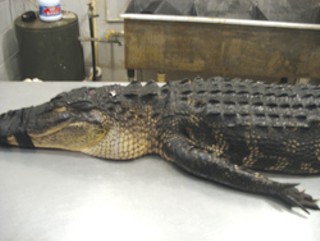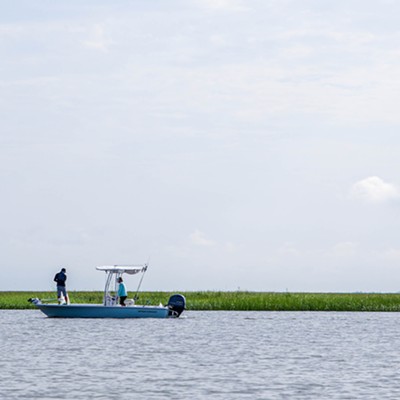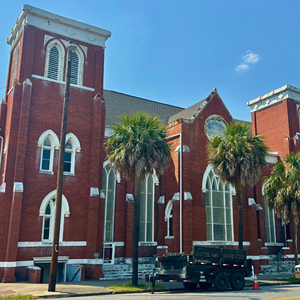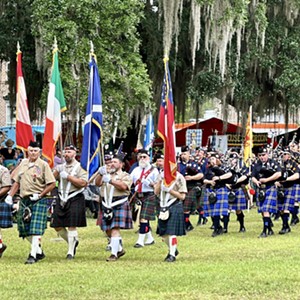AN 82-YEAR-OLD WOMAN house-sitting at The Landings was attacked by an alligator Oct. 5 and died from blood loss.
When her body was recovered, it was missing the left arm, right hand and right foot.
A trapper found the eight-foot alligator and killed it, and it was identified as the killer by its stomach contents. Wildlife biologists are puzzled by the attack, saying such attacks are extremely rare.
“From 1980 to October 2001, there only have been eight reported cases of alligator attacks on humans in Georgia. There have been no fatalities,” says Senior Wildlife Biologist Brooks Good of the Georgia Department of Natural Resources Wildlife Resources Division.
“Six of these incidents happened as a result of the human stepping on or otherwise contacting a submerged alligator,” Good says. “The remaining two incidents were a result of the alligator mistaking the human for prey.”
The American alligator has changed little over the past 180 million years, Good says. They’re among five surviving group of crocodilians, of which there are only two surviving species of alligators -- the Chinese alligator and the American alligator.
At one point, both species were critically endangered, and the Chinese alligator still is. But the rapid comeback of the American alligator is considered a success story among biologists.
“Alligators were hunted to near extinction in the 1950s and early 1960s,” Good says. “Protective action by state and federal governments helped keep them from disappearing completely. This type of protection allowed the alligator population to increase. They were removed from ‘total protection’ status in 1987.”
American alligators are found only in the Southeast. “Alligators occur from the southern tip of Texas to the northeastern part of North Carolina,” Good says.
“There are approximately 200,000 alligators in Georgia and they are typically found south of the fall line, which roughly connects the cities of Columbus, Macon and Augusta,” he says.
Alligators can live up to 60 years in captivity but in the wild they rarely live more than 50 years.
“Male alligators can grow up to 16 feet in length, although 14 footers are rare, and female alligators can grow up to 10 feet. Large alligators can reach weights of over 800 pounds,” Good says.
“Alligators are carnivores and will eat almost anything they can catch,” he says. “During the first few years their diet consists mainly of small prey such as snails, crayfish, frogs, insects and other invertebrates.
“Depending on their size, larger gators may eat fish, turtles, snakes, waterfowl, raccoons, beavers and otters,” Good says. “Alligators also feed on carrion and, given the opportunity, they also may eat pets and smaller domestic animals, such as goats and pigs.”
It’s important to recognize potential alligator habitats. “They’re found in marshes, swamps, rivers, farm ponds and lakes in the wild, but also have been found in ditches, neighborhoods, drainage canals, roadways, golf course ponds and sometimes in swimming pools,” Good says.
“During the courtship and breeding season, April to May, alligators prefer open waters,” he says. “During the remainder of the year, males prefer open and deep waters while females seek out nesting habitat in shallow, heavily vegetated and secluded areas.”
At the same time alligators have rebounded from near extinction, the Southeast’s population has exploded. Development in alligator habitats, such as The Landings, has brought these large lizards into contact with humans.
“In 1989, the Georgia Department of Natural Resources initiated a nuisance alligator program that allows licensed agent trappers to capture and harvest specific nuisance alligators over four feet in length,” Good says. “
But by no means should humans panic, or worse, try to kill all alligators.
“Alligators are important in nature,” Good says. “They help maintain the population balance of certain prey species and they help shape and modify habitats. During times of severe drought, alligators are known to dig holes to concentrate water. This helps the alligator survive, and helps many other species of plants and animals in the area.”
Dr. David Rostal, a professor of biology at Georgia Southern University, has done research among alligator populations in Louisiana.
“We’re pretty careful around them,” he says. “The people we work with know what they’re doing. We make sure to restrain its mouth with rubber bands or electrical tape. Most of their force is in closing their mouths and they don’t have a lot of strength to open them.”
There is at least one thing humans have in common with alligators. “They were the first animal with a four-chambered heart, like we have,” Rostal says.
“They show parental care by guarding their nests,” he says. “The females are quite protective. The time of year you need to be most cautious is June, July and August.”
Alligators aren’t malicious, they’re simply very large predators.
“They’re a killing machine -- it’s what they do,” Rostal says. “They grab their prey from above, take it down and roll with it. The alligator can’t chew. All it can do is tear pieces loose and swallow them whole.”
The recent fatal attack shows it’s necessary to be cautious at all times.
“An attack this late in the year seems strange,” Rostal says. “Probably a lot of us have walked by an alligator and never seen it.”
Increased development along the coast will mean more problems in the future, Rostal says.
“We’re encroaching on the alligators’ habitats,” he says. “There will be even more human and alligator interaction and accidents are going to happen.”
When at all possible, alligators will avoid humans. “There are probably more dogs that get taken than people,” Rostal says.
When alligators do attack humans, it’s often a mistake on their part.
“About three years ago in Florida, an elderly woman was kneeling down gardening when she was attacked,” Rostal says. “She didn’t look like a human to the alligator.”
Despite federal protection, alligators still are hunted illegally. “There is a large illegal trade in alligator and crocodile skins,” Rostal says. “All the other species (of crocodilians) are endangered.”
Yet alligators have recovered enough that some states hold legal hunts.
“There are alligator farms,” Rostal says. “We don’t know why they rebounded so well, but they did.”
Despite alligators’ fearsome reputation, some humans act foolishly around them. “They should be afraid,” Rostal says.
“You should never feed them,” he says. “They become brave if they’re fed. That increases the odds that they’ll come out of the water.”
If there is a nuisance alligator near your house, contact the DNR, Rostal says. “They’ll bring in a trapper who will either move the alligator or kill it,” he says.
Keep your distance when you see an alligator.
“They’re very fast, and have sort of an explosive run,” Rostal says. “They could pop up right next to you.
“If you see a baby alligator, don’t pick it up,” he says. “The mother’s probably still around somewhere. You can get fined for messing with alligators.”
At night, carry a flashlight. “If you see red-eye shine and it’s in the water, it’s an alligator,” Rostal says.
So what happens if you encounter an alligator despite all precautions? “A lot of times, they’ll come out of the water and gape their teeth and try to threaten you,” Rostal says.
“Don’t startle it. If you’re walking, start putting distance between you and it,” he says. “They really don’t go after people and are more afraid than you are.
“I wouldn’t necessarily run unless the alligator is coming after you,” Rostal says. “Move out of the area as calmly as you can. You’re not going to bluff an alligator.”
Humans have many misconceptions about alligators, Rostal says. For example, the tail is actually used for swimming, not fighting.
“It’s an old wives’ tale that the tail is more dangerous than the mouth,” he says. “The mouth is the dangerous part.” 
To comment e-mail us at
letters@connectsavannah.com
The alligator blamed for the recent killing near the Landings























